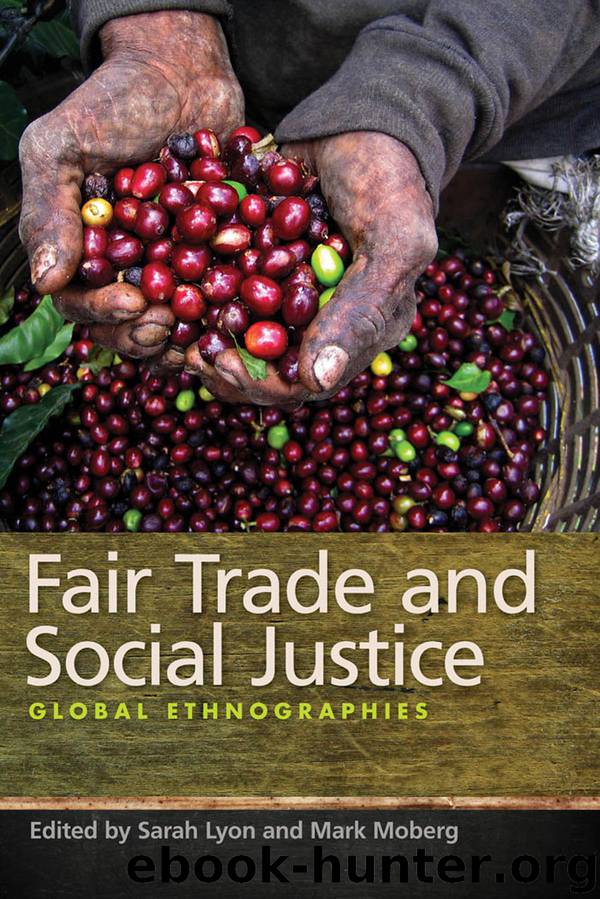Fair Trade and Social Justice by Lyon Sarah; Moberg Mark; & Mark Moberg

Author:Lyon, Sarah; Moberg, Mark; & Mark Moberg
Language: eng
Format: epub
Publisher: New York University Press
Published: 2010-12-08T16:00:00+00:00
Changing the Guard: Shifting Alignments in the Fair Trade Movement
Fair trade promotes an ethical vision that seeks to marry tangible financial rewards for developing-country producers with development outcomes such as empowerment, capacity building, and producer participation. Originally formed as a mechanism for humanitarian assistance, by the 1960s the fair trade movement, largely composed of faith-based, campaign, and community organizations (i.e., alternative trade organizations), had recast its mandate as “justice instead of charity,” aiming to instill norms of fairness and equality into global exchange through the importation of handicrafts from marginalized producers and workers in the South (Low and Davenport 2005; Barratt-Brown 1993). In the late 1980s these disparate “self-governing and self-certifying” fair trade and alternative trade organizations (FTOs and ATOs) came together to form the International Fairtrade Association (IFAT), an institution accredited under international norms and obliged to adopt third-party certification (Renard 2005). By 2007, IFAT had grown to 330 members, drawn from seventy countries, that embody an organizational commitment to grass-roots development and to marketing goods that are produced, imported, and/or distributed through “alternative” market channels (IFAT 2007).
In the 1990s, a second model, spearheaded by the Fairtrade Labelling Organizations International (FLO) was developed to expand the visibility and market access for fair trade goods through mainstream distribution channels (Bezençon and Blili 2006; Renard 2003). Spawned by the establishment of the first fair trade label, Max Havelaar, in 1988, FLO (through its National Initiatives) has become the worldwide standard-setting and certification organization for fair-trade-labeled products, codifying fair trade norms and ideals into a highly regulated certification system.
In contrast to the mission-driven ethos of ATOs, for which fair trade is “more than a market,” FLO and its national affiliates are focused on building the business of fair trade, embracing corporate participation as a way to spread development benefits to more producers (Barrientos and Dolan 2006: 181; Raynolds 2009). Fair-trade-labeled commodities are now sold in twenty countries across Europe, North America, and Asia, with their sales in the United Kingdom topping £700 million in 2008 (Fair-trade Foundation 2009). Though not uncontested, corporate engagement has expanded rapidly and now accounts for a growing proportion of market share. Global giants such as Starbucks, Nestlé, McDonald’s, and Sam’s Club (Wal-Mart) now market fair-trade-certified goods, and in the United Kingdom the major multiples—the Co-op, Safeway, Tesco, and Sainsbury—have all moved into own-brand fair trade products.
The penetration of fair trade into mainstream food production and retailing raises several questions on the type of development the private sector is delivering to small producers and workers. Practitioners and academics suggest that mainstreaming allows companies to capitalize on the “halo effect” of ethical branding, positioning themselves as beneficent global citizens while engendering formidable new barriers to entry (standards, quality requirements, certification, etc.) that cleanse fair trade of its oppositional and transformative elements (Renard 2003; Low and Davenport 2006: 323; Dolan 2008). This “clean washing” assumes various forms, from corporate pursuits of “parallel production”—purchasing only a small proportion of products under fair-trade-certified terms while leaving conventional sourcing strategies intact (Ransom 2005;
Download
This site does not store any files on its server. We only index and link to content provided by other sites. Please contact the content providers to delete copyright contents if any and email us, we'll remove relevant links or contents immediately.
| Anthropology | Archaeology |
| Philosophy | Politics & Government |
| Social Sciences | Sociology |
| Women's Studies |
The Secret History by Donna Tartt(18228)
The Social Justice Warrior Handbook by Lisa De Pasquale(11963)
Thirteen Reasons Why by Jay Asher(8472)
This Is How You Lose Her by Junot Diaz(6463)
Weapons of Math Destruction by Cathy O'Neil(5854)
Zero to One by Peter Thiel(5507)
Beartown by Fredrik Backman(5372)
The Myth of the Strong Leader by Archie Brown(5249)
The Fire Next Time by James Baldwin(5033)
How Democracies Die by Steven Levitsky & Daniel Ziblatt(4971)
Promise Me, Dad by Joe Biden(4916)
Stone's Rules by Roger Stone(4874)
100 Deadly Skills by Clint Emerson(4700)
A Higher Loyalty: Truth, Lies, and Leadership by James Comey(4566)
Rise and Kill First by Ronen Bergman(4554)
Secrecy World by Jake Bernstein(4407)
The David Icke Guide to the Global Conspiracy (and how to end it) by David Icke(4396)
The Farm by Tom Rob Smith(4332)
The Doomsday Machine by Daniel Ellsberg(4253)
